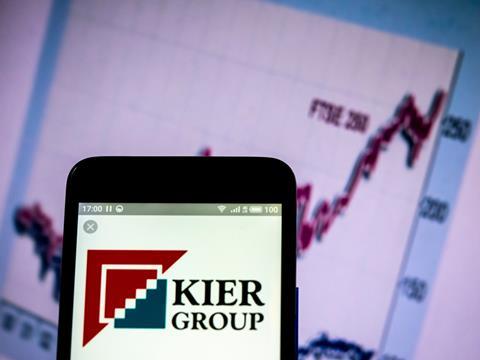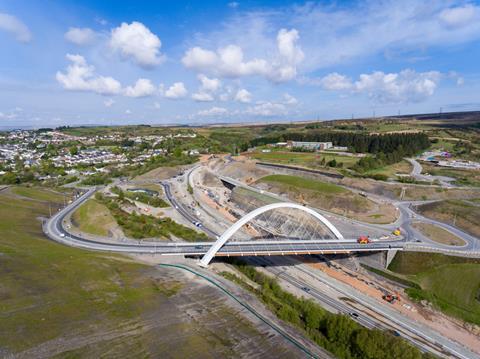Galliford Try is another trying to get back on track with all three firms reckoning on better days ahead. Dave Rogers takes a look at the figures
It was a technical issue after all but, of all the companies to see its annual results delayed by a glitch – apparently due to the timing of getting all parties signing off for the London Stock Exchange deadline – it had to be Kier.
When last Thursday the firm’s 2020 numbers were eventually released, more than two and a half hours after they were supposed to be, the picture painted was of a business where the long-term outlook was better than the impression that a £225m pre-tax loss might have actually given.
Chief executive Andrew Davies said: “Kier needs substantial restructuring but has great potential.” He added the firm was “well placed” to benefit from a planned government spending spree on infrastructure.
Covid deals a £500m blow to Kier’s revenue

In its results, the firm said revenue had been hit to the tune of £500m because of the impact of covid-19 – the pandemic badly affected its key last quarter of trading – with pre-tax losses roughly on a par with last year’s – although losses for the year to June were actually £273m since these included those racked up at its discontinued housing business.
The firm said it had spent £156m on restructuring costs with one of the headline-grabbing numbers being the number of staff that have left since a strategic review was launched by Davies last June.
The debt position is worse but for understandable reasons
Kevin Cammack, Cenkos
He had promised 1,200 by the 2020 financial year-end but in fact that number has gone up by more than 40% to 1,700. In two years, 15% of staff have left.
“The cost reduction programme has been taken deeper,” Cenkos analyst Kevin Cammack says. “They’re getting to grips with that more aggressively which should be taken as a positive rather than a concern.”
But Applied Value analyst Stephen Rawlinson warns against cutting too much: “The goal is to save at least £100m a year of costs. As outsiders, it’s always hard to know how much productive capacity has been removed.”
While £100m of annual savings from next year might appeal, analysts are also wondering how the firm will eat into its debt, which remains stubbornly high. Its year-end net debt went up from £167m to £310m while average month-end net debt went up to £436m from £422m.
One way of getting this down is through disposals and the key sale is its housing arm Kier Living. But the pandemic has put any deal back by up to a year, the firm said, with Kier warning the due diligence with interested parties begun pre-covid will have to start all over again.
Cammack reckons Kier’s management will just to have accept that they are not going to get what they first reckoned they might from the business. “If it was between £90m and £100m, I’m guessing if they got that, they’d take it.”
Still, Kier has bought itself some time by agreeing waivers with its lenders in respect of its financial covenants.
“The one thing to be concerned about is that debt has gone the wrong way, though they’re trying to put much of that at the door of covid,” Cammack adds. “I don’t think the results are too bad. The debt position is worse – but for understandable reasons.”
Davies, who Cammack says cut a less despondent figure on an analysts’ call last Thursday, still has a lot of goodwill behind him.
But he warns: “By this time next year, we’ve got to see some of his actions bearing fruit in terms of performance of the business. If not, it says that it’s proving a very difficult task to turn the tanker around.”
Rawlinson adds: “The picture Kier management paints is one of a business with great potential. There is some truth in that, of course. But [the] business remains in real difficulties and is dependent on the debtholders’ patience and generosity. It is also dependent on the government projects coming through.”
Kier’s share price closed 12% up on the day of its results to 61p – still way short of what it once was. In February, it was close to 150p. Five years ago, on 18 September 2015, it was 1356p.
The key to repairing the share price is strengthening its balance sheet, says Numis analyst Johnny Coubrough. “Kier is in a strong position,” he says. “However, the inherited weak balance sheet means that net debt reduction is the key priority for the group and it is clear that [covid] has created additional difficulties in achieving this. Improvement of the balance sheet would lead to a re-rating of the shares to reflect the operational qualities of the business.”
Costain and its £92m loss
Kier was not the only main contractor reporting its results last week. Costain announced its delayed interim figures at the start of the week, racking up a £92m pre-tax loss.
“It’s one disaster after another,” says Building Value’s Tony Williams. Costain says the blame for the red ink lies in two problem contracts – a road scheme for the Welsh government in south Wales called the Heads of the Valley, which involves dualling a five-mile stretch of the A465, and a second scheme for National Grid to upgrade compressor stations in Peterborough and Huntingdon.
The A465 is due to be finished next year but the National Grid job has turned so sour that Costain has left it – but is chasing £49.3m in missing money for work it says it has completed.
These are not the first problem contracts Costain has had to deal with in recent years. “The key to being successful as a contractor is like golf,” Williams says. “Keep a ‘six’ off your card [but] Costain has had too many.”
A £400m contract, signed in 2009, to design and build 43 facilities across 27 sites as part of Greater Manchester Waste Authority’s £3.8bn waste management project racked up a series of losses and last year it was hit by a £9.7m bill to fix a roof at the £260m National Synchrotron facility it completed in Oxfordshire in 2006.
“The A465 should be a bread and butter contract,” reckons Cammack. “They massively took their eye off the ball.”

One rival who has worked in both building and civil engineering is scathing that the firm has lost so much money on civils jobs. “Civil engineering contracts are generally much fairer and better than building contracts,” he says, suggesting it is unusual to get caught out by unfavourable contract clauses for this type of work – but that this seems to have happened to Costain.
Costain chief executive Alex Vaughan, who took over from Andrew Wyllie last May, has recognised as much and in last week’s announcement made a point of detailing what the firm has done to tighten things up.
He said two leadership layers had been removed with the firm bringing in a new managing director of its transport business, Sue Kershaw, reporting directly to Vaughan.
Cammack says the moves are overdue but adds: “It will be scant consolation that investors have had to fill this financial hole with an equity raise in May.”
That has seen the firm rake in £93m with Dubai contractor ASGC becoming its biggest shareholder with a 15% stake.
But analysts point out that more money is due to come out of the business on the two problem jobs as well as £25m in deferred PAYE and VAT payments. “In short, Costain will be little better off in cash terms come December 2020 than it was in December 2019,” says Cammack. “Costain will surely need to demonstrate real progress to convince investors of its renaissance.”
Costain’s earnings targets are margins of between 6% and 7% by 2024. Cammack also needs convincing they are plausible: “Heady stuff but understandably the market is reluctant to buy into that just now.”
Rawlinson warns: “The path to 6% margins and low risk needs to be shown and for some investors proven, so it will take a while.”
Galliford Try’s targets
The day before Kier’s results, Galliford Try, another firm that once mixed contracting with housebuilding, posted its annual figures.
The firm’s chief executive Bill Hocking wants revenues of somewhere between £1.2bn and £1.5bn and is hoping for margins at around 1.6%, up to 2% by 2022.
It all sounds modest enough – compared with the eyebrow-raising numbers quoted by Costain – but the firm has been bruised by the money it shipped on two huge infrastructure projects in Scotland – the Queensferry Crossing and the Aberdeen bypass.
The jobs in part led to the sale of the firm’s housing arm to Bovis Homes at the start of this year.
Hocking admits to a slice of good fortune the deal was completed when it was in very early January before all covid hell broke loose.
Rawlinson says: “The sale of the housebuilding operations has allowed the company to rebase itself with an extremely strong balance sheet following the issues related to some contracts, Aberdeen in particular. The key will be avoiding bad contracts and the evidence so far is that it is behaving cautiously and not chasing work.”
Cammack says Galliford Try has set itself achievable targets but adds: “They’re presenting themselves as a recovery story. I feel there should be a bit more to it. It’s all OK but it needs a bit more substance and ambition.”
But he also warns firms against over-ambition. Whose shoes would he rather be in, then? Kier or Costain? “Kier is in a worse position at the moment,” Cammack says. “Kier are promising a recovery but I worry Costain is overpromising on what their recovery is.” With the impact of covid still to be fully played out, predicting the shape of any firm’s recovery is at this stage largely guesswork.



























No comments yet